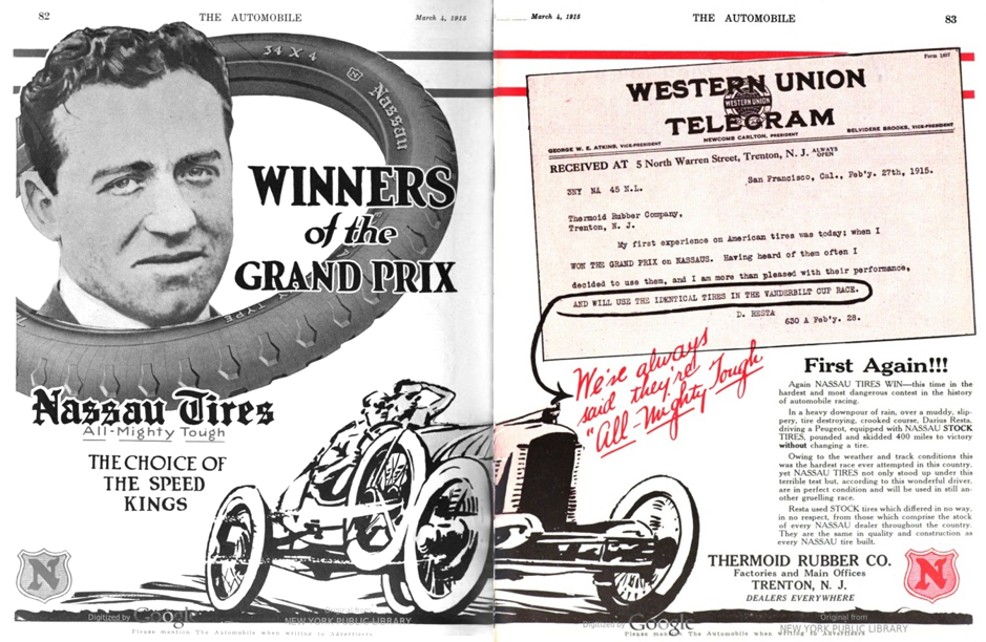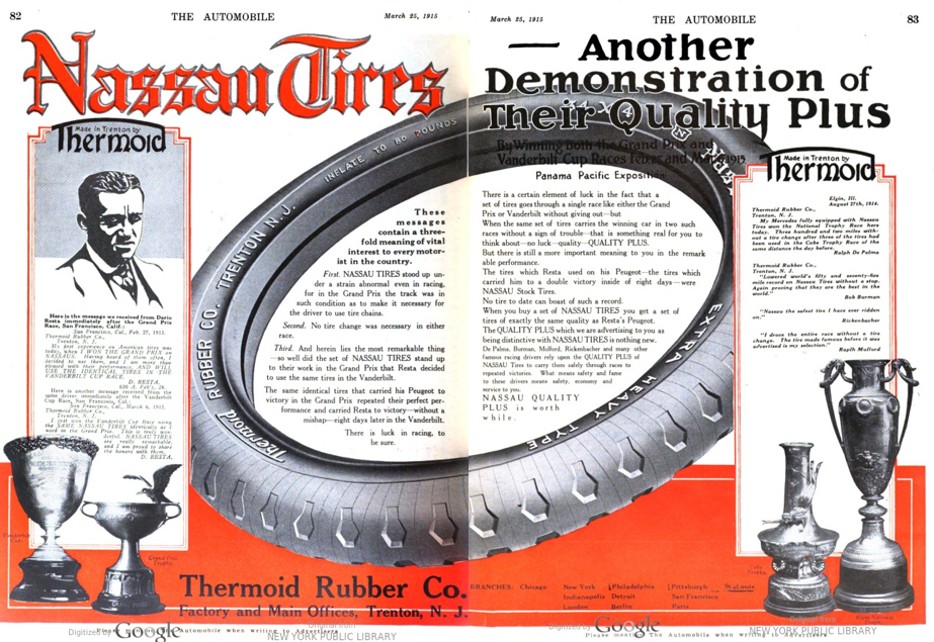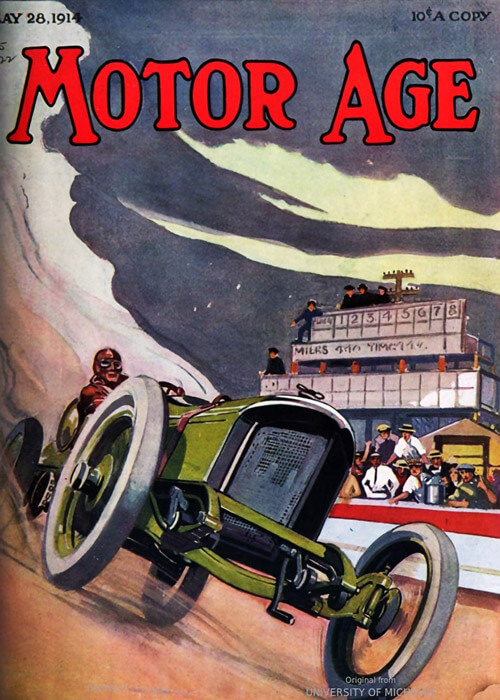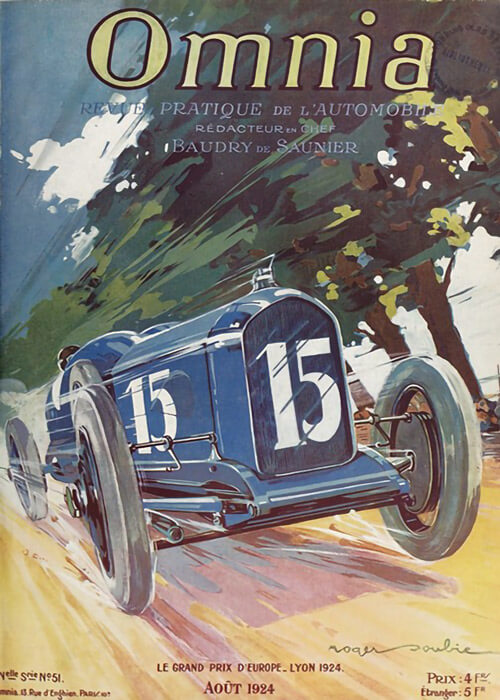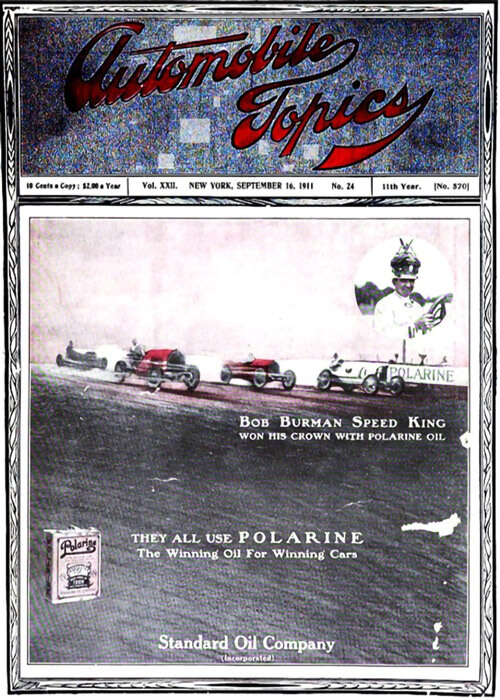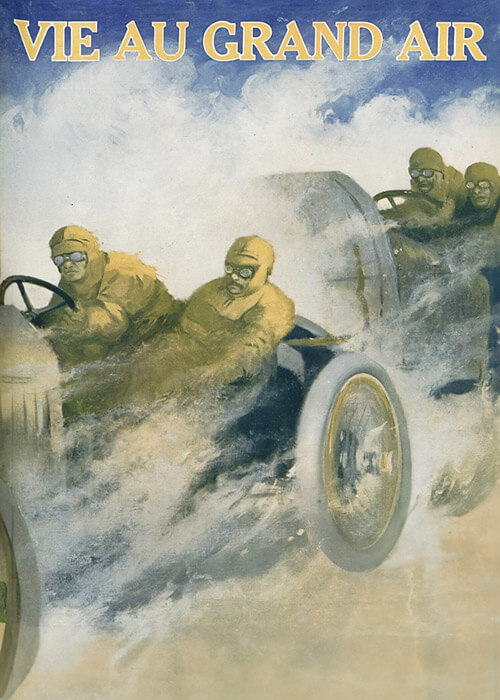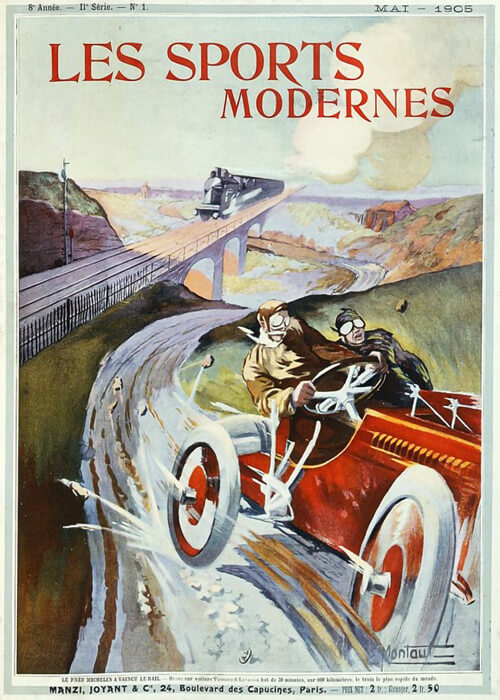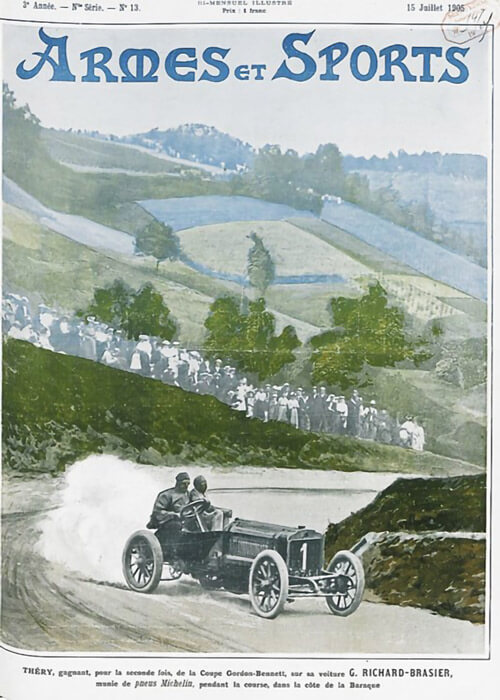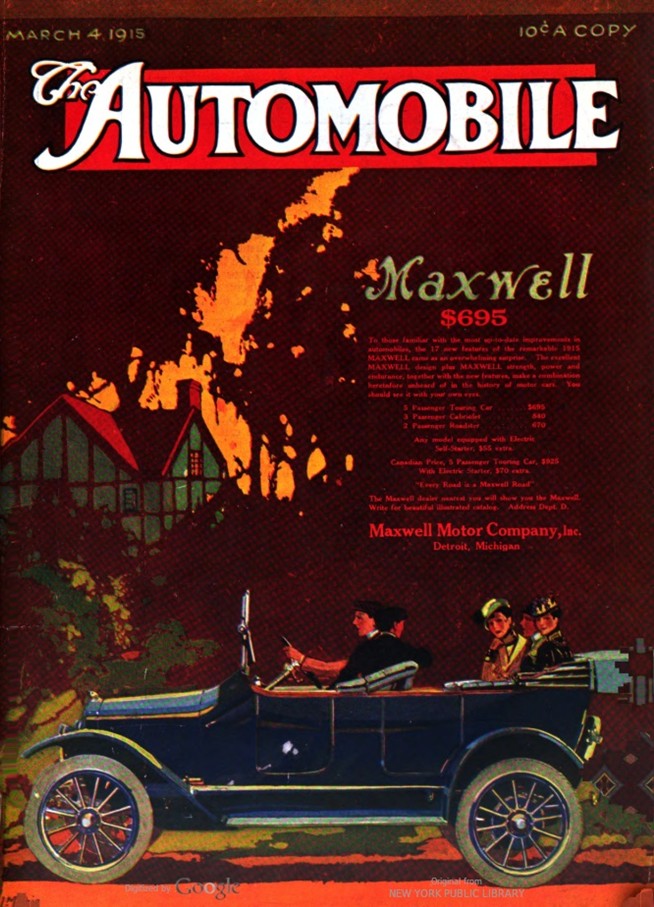
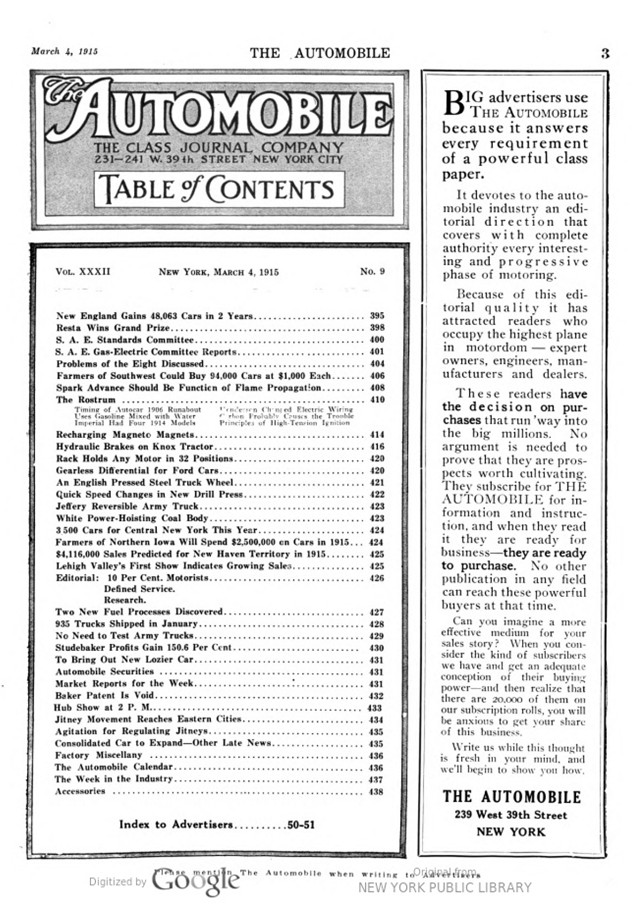


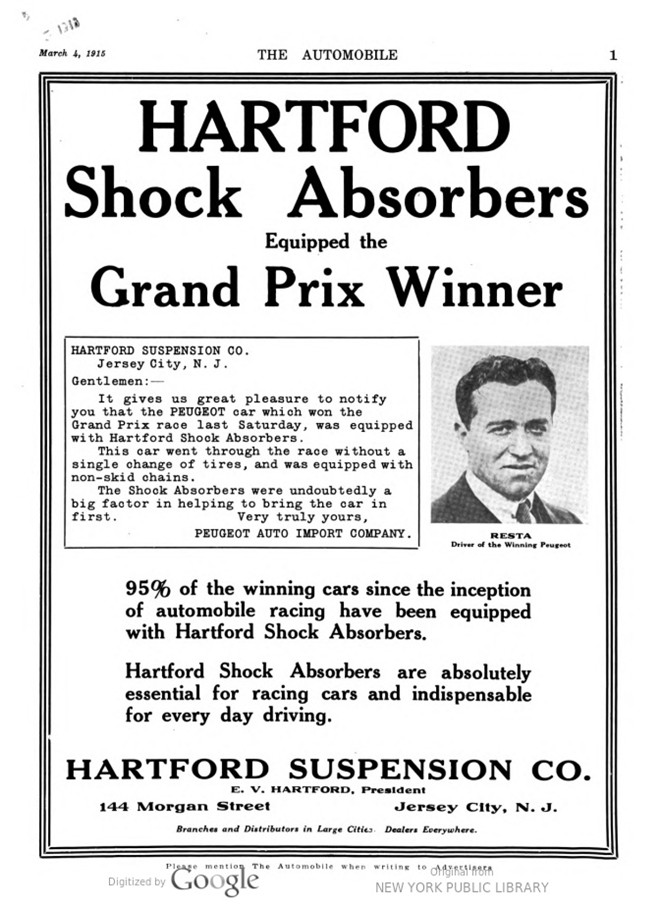
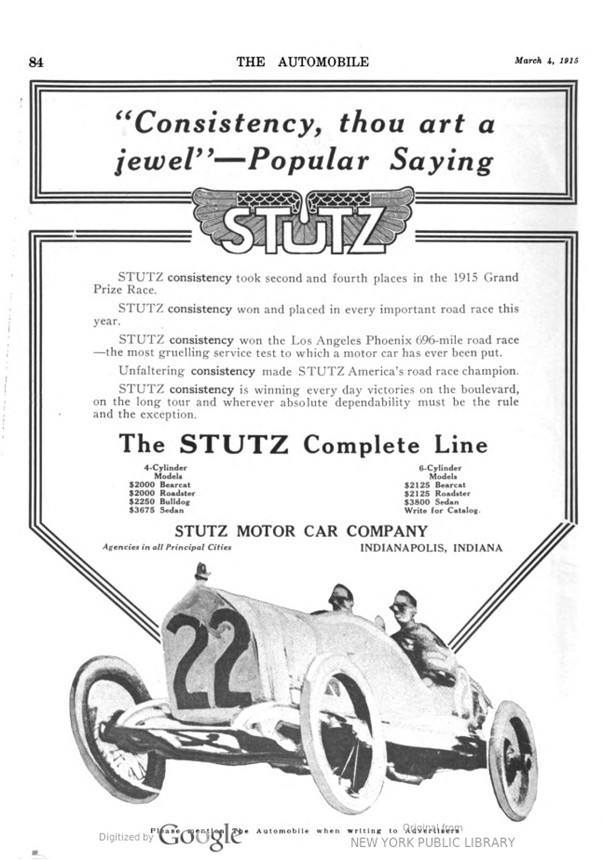
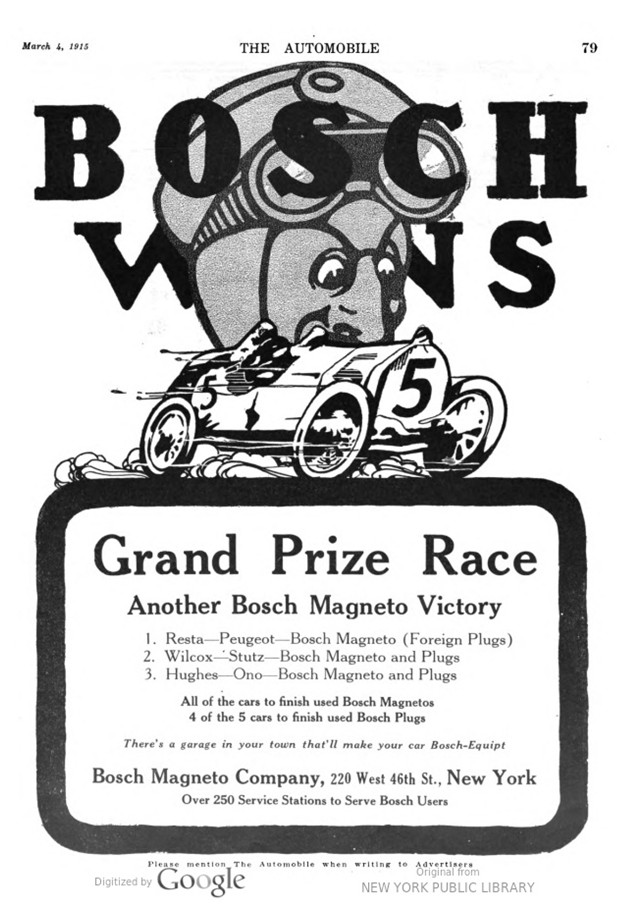
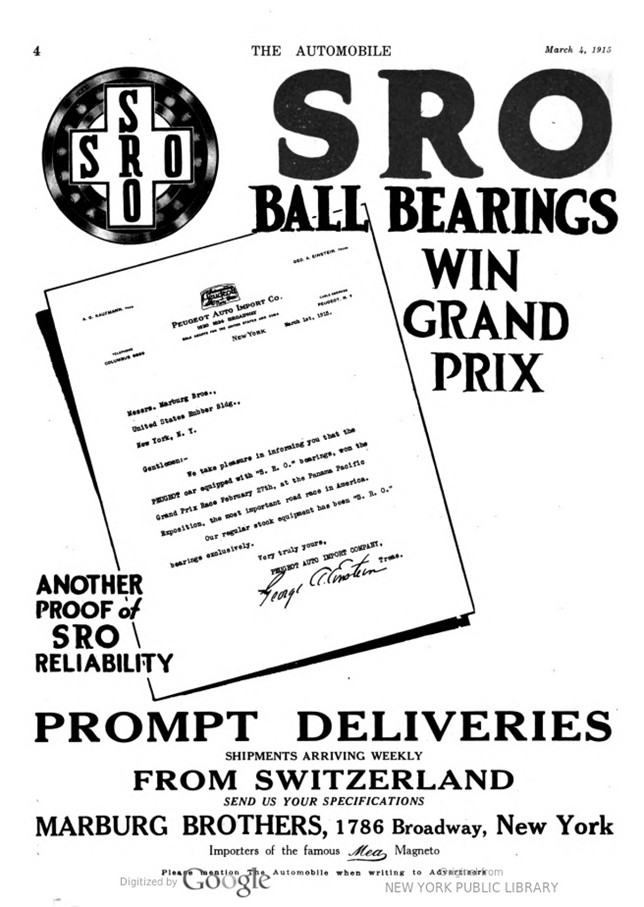
Authorised by hathitrust.org. Text and photos compiled by motorracingistory.com
The Automobile Vol. 32, Jan-March 1915, No.9, March 4, 1915, pages 398 – 399
Resta Wins Grand Prize
Peugeot, Skidding and Sliding, Covers 400.2856-Mile Track at 56.12 M.P.H. in Driving Rain – Wilcox, in Stutz, Second – Hughes‘ Ono Third
Drivers Claim Course Is Not Fit for Vanderbilt – Many Wish to Withdraw
By A. G. Waddell
SAN FRANCISCO, CAL., Feb. 27 – Special to THE AUTOMOBILE – Dario Resta, driving a Peugeot, today piloted his car to the front in the sixth grand prize race for the gold cup of the Automobile Club of America and $3,000 in prize money. He covered the 400.2856 miles or 104 laps in 7 hours, 7 minutes and 57 seconds, an average of 56.12 miles per hour and the slowest time ever made in the history of the grand prize, due to the fact that the major part of the contest was run in a driving rainstorm. The fact that the course was perhaps the slipperiest that drivers in a classic automobile race have had to contend with makes the story of the race one of the daring of the drivers as much as the stamina of the cars.
Winners of Grand Prize Race
Car Driver M.P.H. Prize
Peugeot Resta 56.12 $3,000
Stutz Wilcox 55.26 2,000
Ono Hughes 54.37 1,500
Stutz Anderson 53.15 1,000
Simplex Disbrow 52.79 500
Although the victory is again the result of a foreign combination, American cars and drivers forced the victors to their utmost throughout the entire distance. Howdy Wilcox, driving a Stutz. was second to pilot his skidding mount across the finishing line. He was 7 minutes behind the Peugeot. Hughie Hughes, now an English citizen, driving an Ono car, a combination consisting of a Fiat chassis with a Pope-Hartford motor, was third. Gil Anderson and his Stutz took fourth money, and Louis Disbrow, with the Simplex of dirt-track fame, was fifth to complete the muddy journey and the last man to get the checkered flag of the starter, signifying the race was over.
Eight Still Running
At the time the Simplex finished eight other cars were still running. These were Louis Nikrent’s Mercer, Harry Grant’s Case, Tommy McKelvy’s Overland, Kennedy’s Edward special, Jack Gable’s Tahis, Newhausen’s Delage, Durant’s Chevrolet and Taylor’s Alco. Of the remaining cars ten had been withdrawn, not through mechanical trouble but because their drivers did not believe in taking chances on the slippery course. These included the following: Carlson, Maxwell; Alley, Duesenberg; LeCain, Chevrolet; Pullen, Mercer; De Palma, Mercedes; Herne, Case; Ruckstall, Mercer; Parsons, Parsons special; O’Donnell, Duesenberg; Gordon, Gordon special; and Bragg, Californian.
During the race seven cars were forced to abandon their attempt due to injuries which put them out of the race. Earl Cooper’s Stutz, before the opening of this great skidding contest, one of the favorites, sustained a broken crank- case after the fourth lap. The German Bugatti, driven by Marquis, had to drop out in the tenth lap with ignition trouble. Lou Gandy wrecked the Edward special, skidded into a straw bank on the northwest corner of the course, breaking his steering gear and putting himself out on the twenty-third lap. A broken piston on the Maxwell was the cause of Barney Oldfield’s retirement on the twenty-ninth lap. Caleb Bragg, winner of the grand prize in 1912, was forced to abandon the contest after driving 126 miles because he had no non-skid tire in his pit. Rickenbacher’s Maxwell dropped out on the forty-fourth lap, the reason being attributed to fouled spark plugs. Klein’s King stopped in the forty-eighth circuit with a broken piston.
Although thirty cars were lined up at the start, the field was five less than that shown in the original entry list. The drivers who abandoned the contest, probably due to a premonition of the dangers of the course, were Erwin and Grover Bergdoll, in the Benz and Erwin special, respectively; Tomasini, pilot of the Tomasini special; Gates with the Renault; and Francis on the Francis-Blackman special. Nearly all held that the course was too dangerous to render the race worthwhile.
Speed Dropped 10 Miles
The race was started promptly at 10:30 a. m. by Starter Wagner who sent the cars away in groups of three. At that time, although the weather was threatening, rain had not commenced to fall and did not until about 100 miles had been covered by the leaders. The pace up to this time showed that the time would have been close to the 70-mile mark had dry weather continued. Before the rain Resta was averaging 68 miles per hour and his pursuers were going more than 60. As soon as the deluge started the speeds were materially reduced and the two right angle curves on the course commenced to be taken at speeds as low as 25 miles per hour. After 80 miles, if it is reported, Resta equipped his car with non-skid chains on all four wheels.
The course of macadam and planks soon became so treacherous that ten of the thirty drivers who started withdrew, refusing to take further chances in the driving downpour. The 68,000 people in attendance experienced a series of thrills which rarely if ever have been equaled on an automobile racecourse. Car after car slid from side to side and once Jim Parsons turned completely around in attempting to avoid a statue on the course. His car was headed straight for San Francisco Bay when finally, he managed to bring it to a stop. That no one was injured during the entire day is only due to the good fortune of the drivers. Lou Gandy narrowly escaped disaster when his car went head-on into a bank of straw breaking his steering gear. Neither he nor his mechanic was injured, although their escape was miraculous. Pullen and DePalma skidded into the hay bulwarks so often that the crowds on the turns began to accept it as a regular occurrence. The drivers themselves are amazed that they are all safe and sound and none of their mates are occupying any of the local hospital wards.
Ralph DePalma withdrew after completing sixty-seven laps. Although his Mercedes was in condition to continue he believed it was foolhardy to take any more chances on the hazardous course, especially in view of the fact that he is entered in the Vanderbilt Cup race to be run next Saturday and he did not wish to injure his prospects for that race. Two other favorites to withdraw were Barney Oldfield and Ed Pullen. This left the race to the dark horses. Resta had never driven in America before but he had become famed through his driving of the Sunbeam at Brooklands and his victory in the 1912 French Coupe de L’Auto. His daredevil driving soon brought the spectators to the realization that this new invader from Europe was a master of his car in wet treacherous conditions. The manner in which he guided his torpedo-shaped car in spite of the rain and on the greasy, slippery roads was a revelation.
Gasoline Cost Hughes $500
Hughie Hughes, reinstated within the week by the American Automobile Assn., was Resta’s most dangerous rival throughout the struggle. He was always close to the winner and for ten laps showed the way. This was between the eighty-fifth and ninety-fourth circuit. At that time, he ran out of gasoline on the back stretch and his mechanic was forced to sprint the course to the pits for fuel. The time lost in spite of the fleetness of foot of the mechanician was never made up and at the finish Wilcox led Hughes by 7 minutes. The gasoline required to go halfway around the course cost Hughes $500.
Anderson and Hughes came among the moneyed five only after the fortieth lap was finished. At that time Ed Pullen was running in fourth place. At first the officials gave Disbrow fourth, but a rechecking of the tables put him in fifth place and the Stutz fourth.
Foreign-built cars have won the grand prize five out of the six times it has been run. The only American triumph was scored last February when Eddie Pullen, pilot of the Mercer, captured the trophy at Santa Monica. Previous to 1914, the winners were Caleb Bragg, in an Italian Fiat in 1912, David Bruce-Brown, Fiat, 1911, and Benz, 1910, and Louis Wagner in a Fiat in 1909.
Drivers Protest Vanderbilt Course as Unfit
SAN FRANCISCO, CAL., March 1 – Special Telegram – Unless there is a change of feeling among the drivers between now and Saturday, the Vanderbilt cup race, to be run over the Panama-Pacific exposition course March 6, will be a huge farce and the premier motor contest of America will be a comedy of laughs instead of a struggle of thrills.
At the completion of the water-soaked grand prize race, many of the drivers declared that they would not start in the Vanderbilt cup classic and threatened to leave San Francisco immediately. They will be compelled to remain, however, and start Saturday under penalty of being blacklisted by the American Automobile Assn. if they do not. Had they given formal notice of their withdrawal from the lists immediately after the announcement of the postponement of the Vanderbilt cup race from February 22 to March 6, they would have been safe and the governing body could not disqualify them. The drivers claim that the course is unfit for racing.
Despite the storm of protests and the existing dissatisfaction, the list of starters in the Vanderbilt cup race Saturday will be the same as that announced for February 22 with three exceptions. Erwin Bergdoll has been released by the management and has shipped the Erwin Special and the Benz, a reserve car, to Philadelphia. Bergdoll was injured in practice when his car went through the fence. Tomasini may not be allowed to start as the other drivers claim that he is not capable. The Renault, formerly owned by Barney Oldfield and now the property of Ivan R. Gates, of San Francisco, also has been withdrawn. It was not permitted to compete for the grand prize as it was regarded as dangerous.
Photo Captions – The Automobile
Page 398 – The Winner DARIO RESTA Peugeot
2nd WILCOX Stutz – 3rd HUGHES Ono – 4th ANDERSON Stutz – 5th DISBROW Simplex
Page 399
START-FINISH A pit scene on the Vanderbilt and Grand Prize race track, with Anderson’s Stutz in the foreground
